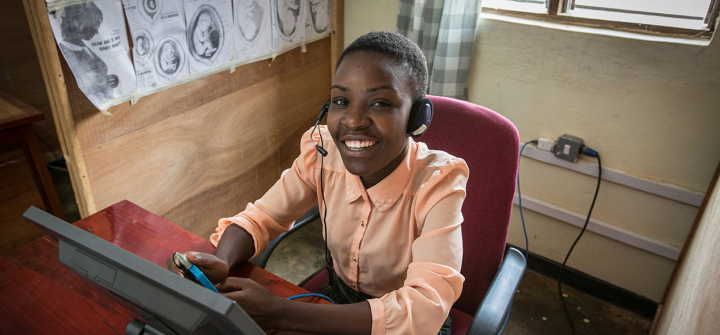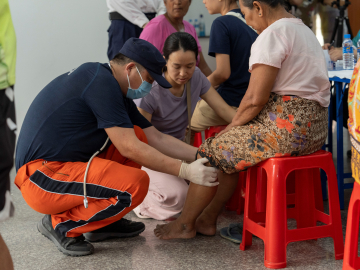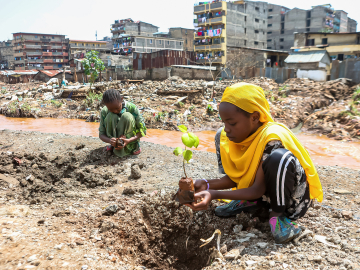Leveraging Technology to Bridge Health System Gaps
In 2023, nearly 3 million additional children were left un- and under-vaccinated compared to pre-pandemic levels, revealing that global immunization has yet to recover. We know where these children are (mostly in fragile and conflict-affected countries), and which vaccines they missed (measles vaccines, among others)—important data points that will inform how and where to direct immunization services and investment in the future.
What’s missing is an understanding of community preferences and perspectives on when, where, and how they receive immunizations and other primary health care services—information that is critical for designing health systems that meet the needs of everyone, even in the most under-reached communities.
Yet the effective collection, analysis, and utilization of this data faces significant hurdles. African populations are severely under-represented in data sets used to inform data science models for health applications, and few countries systematically gather feedback from their own citizens. This results in a disconnect between community needs and health system services.
Technology can bridge these gaps, making it easier to routinely collect, analyze, and synthesize feedback, and “close the loop” by showing communities how their feedback drove meaningful changes. This approach forms the basis of the Community Insights to Action (CITA) Framework, which offers countries a model for designing and implementing community-centered health programs.
For example, tools such as mobile health apps, health hotlines, digital avatars, and chatbots can help under-reached communities share feedback consistently and discreetly. This can be especially useful in remote locations with limited access to health facilities, or when feedback pertains to sensitive topics, such as sexual and reproductive health.
We’ve seen this through our own work collaborating with the government of Malawi on a health hotline, which has played a key role in disseminating health information, collecting community insights, and even tracking the spread of misinformation and identifying early signs of potential polio and cholera outbreaks. In another example, Pulse Lab Kampala is using machine learning to analyze radio content in Uganda, extracting insights on issues like health care, education, and governance, which has informed public communications during the COVID-19 pandemic and outbreak tracking.
These collection tools can be incredibly helpful, but to be most useful, the data must also be easily accessible and digestible. That’s why feeding community insights collected into a centralized system, such as national digital electronic records, is critical. This can enable health workers to rapidly identify areas with low health care coverage or supplies, tailor communications to specific populations, and focus on communities with the greatest need.
Finally, technology—such as routine, tailored communications via SMS text—can facilitate the “feedback loop,” and demonstrate how community feedback leads to change. When community members see tangible outcomes resulting from their feedback, studies show that they are more likely to continue engaging with the health system—which, in turn, can improve health outcomes.
However, while tech solutions hold enormous potential to transform health care, existing inequities and structural challenges stand in the way. Access to digital devices and internet connectivity mirrors broader socioeconomic inequities, and factors such as literacy and digital literacy affect the relevance and usability of these solutions, further marginalizing the most under-reached.
Concerted efforts are needed to address this digital divide, specifically:
- Multisectoral action to improve fragmented data systems and invest in infrastructure improvements that make internet and mobile networks and digital tools more accessible and affordable.
- Organizations should prioritize accessibility in the solutions they implement.
- Mechanisms must be put in place to incentivize policymakers and health actors to prioritize the integration of community insights into their decision-making.
Africa has no shortage of innovative technologies, and the continent’s growing health tech sector is driving a health and development revolution. The impact of these tools on the health and well-being of communities, however, will ultimately depend on how they are used.
We must seize the opportunity we have now to close the gap. By strategically deploying technology to center community needs in the design and delivery of health care, we can make significant progress toward ensuring that everyone, everywhere, has access to quality, affordable care when, where and how they need it.
Swetha Srinath, MPH, is the acting Data Analytics team lead, Christine Lenihan, MPH, is senior manager of Digital Solutions, and Emily Lawrence, MPH, is director of Research, Evidence and Learning for VillageReach, where she leads work around the Community Insights to Action (CITA) Framework.
Join the 50,000+ subscribers in 170+ countries who rely on Global Health NOW summaries and exclusive articles for the latest public health news. Sign up for our free weekday newsletter, and please share the link with friends and colleagues.
A health care worker connects with callers from the community using Chipatala Cha Pa Foni (Health Center by Phone). Lilongwe, Malawi in 2016. Paul Joseph Brown







